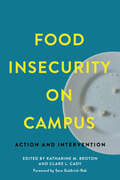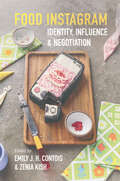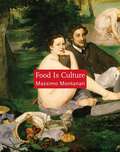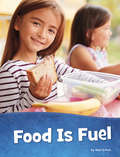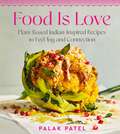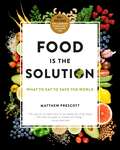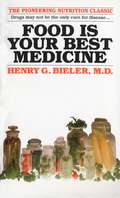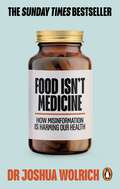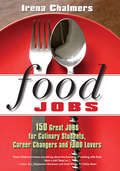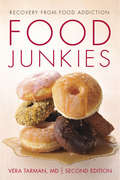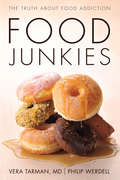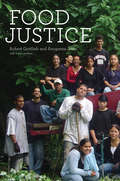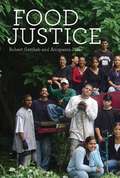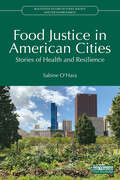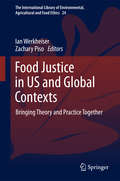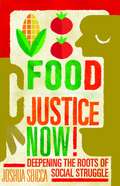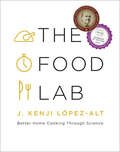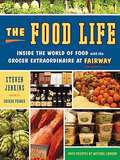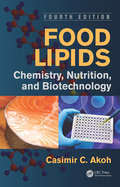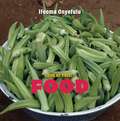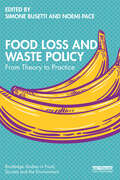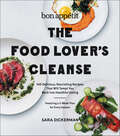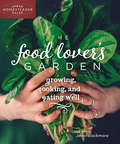- Table View
- List View
Food Insecurity on Campus: Action and Intervention
by Katharine M. Broton and Clare L. CadyThe hidden problem of student hunger on college campuses is real. Here's how colleges and universities are addressing it.As the price of college continues to rise and the incomes of most Americans stagnate, too many college students are going hungry. According to researchers, approximately half of all undergraduates are food insecure. Food Insecurity on Campus—the first book to describe the problem—meets higher education's growing demand to tackle the pressing question "How can we end student hunger?" Essays by a diverse set of authors, each working to address food insecurity in higher education, describe unique approaches to the topic. They also offer insights into the most promising strategies to combat student hunger, including• utilizing research to raise awareness and enact change; • creating campus pantries, emergency aid programs, and meal voucher initiatives to meet immediate needs;• leveraging public benefits and nonprofit partnerships to provide additional resources;• changing higher education systems and college cultures to better serve students; and• drawing on student activism and administrative clout to influence federal, state, and local policies.Arguing that practice and policy are improved when informed by research, Food Insecurity on Campus combines the power of data with detailed storytelling to illustrate current conditions. A foreword by Sara Goldrick-Rab further contextualizes the problem. Offering concrete guidance to anyone seeking to understand and support college students experiencing food insecurity, the book encourages readers to draw from the lessons learned to create a comprehensive strategy to fight student hunger.Contributors: Talia Berday-Sacks, Denise Woods-Bevly, Katharine M. Broton, Clare L. Cady, Samuel Chu, Sarah Crawford, Cara Crowley, Rashida M. Crutchfield, James Dubick, Amy Ellen Duke-Benfield, Sara Goldrick-Rab, Jordan Herrera, Nicole Hindes, Russell Lowery-Hart, Jennifer J. Maguire, Michael Rosen, Sabrina Sanders, Rachel Sumekh
Food Instagram: Identity, Influence, and Negotiation
by Laurence Allard Joceline Andersen Emily Buddle Robin Caldwell Sarah Cramer Gaby David Sara Garcia Santamaria Deborah Harris Kc Hysmith Alex Ketchum Katherine Kirkwood Jonatan Leer Yue-Chiu Bonni Leung Yi-Chieh Jessica Lin Rachel Phillips Michael Z. Newman Tsugumi Okabe Tara Schuwerk Stinne Gunder Krogager Sarah E Tracy Emily Truman Dawn Woolley Zara WorthImage by image and hashtag by hashtag, Instagram has redefined the ways we relate to food. Emily J. H. Contois and Zenia Kish edit contributions that explore the massively popular social media platform as a space for self-identification, influence, transformation, and resistance. Artists and journalists join a wide range of scholars to look at food’s connection to Instagram from vantage points as diverse as Hong Kong’s camera-centric foodie culture, the platform’s long history with feminist eateries, and the photography of Australia’s livestock producers. What emerges is a portrait of an arena where people do more than build identities and influence. Users negotiate cultural, social, and economic practices in a place that, for all its democratic potential, reinforces entrenched dynamics of power. Interdisciplinary in approach and transnational in scope, Food Instagram offers general readers and experts alike new perspectives on an important social media space and its impact on a fundamental area of our lives. Contributors: Laurence Allard, Joceline Andersen, Emily Buddle, Robin Caldwell, Emily J. H. Contois, Sarah E. Cramer, Gaby David, Deborah A. Harris, KC Hysmith, Alex Ketchum, Katherine Kirkwood, Zenia Kish, Stinne Gunder Strøm Krogager, Jonathan Leer, Yue-Chiu Bonni Leung, Yi-Chieh Jessica Lin, Michael Z. Newman, Tsugumi Okabe, Rachel Phillips, Sarah Garcia Santamaria, Tara J. Schuwerk, Sarah E. Tracy, Emily Truman, Dawn Woolley, and Zara Worth
Food Is Culture (Arts and Traditions of the Table: Perspectives on Culinary History)
by Massimo MontanariElegantly written by a distinguished culinary historian, Food Is Culture explores the innovative premise that everything having to do with food—its capture, cultivation, preparation, and consumption—represents a cultural act. Even the "choices" made by primitive hunters and gatherers were determined by a culture of economics (availability) and medicine (digestibility and nutrition) that led to the development of specific social structures and traditions.Massimo Montanari begins with the "invention" of cooking which allowed humans to transform natural, edible objects into cuisine. Cooking led to the creation of the kitchen, the adaptation of raw materials into utensils, and the birth of written and oral guidelines to formalize cooking techniques like roasting, broiling, and frying. The transmission of recipes allowed food to acquire its own language and grow into a complex cultural product shaped by climate, geography, the pursuit of pleasure, and later, the desire for health. In his history, Montanari touches on the spice trade, the first agrarian societies, Renaissance dishes that synthesized different tastes, and the analytical attitude of the Enlightenment, which insisted on the separation of flavors. Brilliantly researched and analyzed, he shows how food, once a practical necessity, evolved into an indicator of social standing and religious and political identity. Whether he is musing on the origins of the fork, the symbolic power of meat, cultural attitudes toward hot and cold foods, the connection between cuisine and class, the symbolic significance of certain foods, or the economical consequences of religious holidays, Montanari's concise yet intellectually rich reflections add another dimension to the history of human civilization. Entertaining and surprising, Food Is Culture is a fascinating look at how food is the ultimate embodiment of our continuing attempts to tame, transform, and reinterpret nature.
Food Is Culture
by Montanari Massimo Sonnenfeld AlbertElegantly written by a distinguished culinary historian, Food Is Culture explores the innovative premise that everything having to do with food-its capture, cultivation, preparation, and consumption-represents a cultural act. Even the "choices" made by primitive hunters and gatherers were determined by a culture of economics (availability) and medicine (digestibility and nutrition) that led to the development of specific social structures and traditions. Massimo Montanari begins with the "invention" of cooking which allowed humans to transform natural, edible objects into cuisine. Cooking led to the creation of the kitchen, the adaptation of raw materials into utensils, and the birth of written and oral guidelines to formalize cooking techniques like roasting, broiling, and frying. The transmission of recipes allowed food to acquire its own language and grow into a complex cultural product shaped by climate, geography, the pursuit of pleasure, and later, the desire for health. In his history, Montanari touches on the spice trade, the first agrarian societies, Renaissance dishes that synthesized different tastes, and the analytical attitude of the Enlightenment, which insisted on the separation of flavors. Brilliantly researched and analyzed, he shows how food, once a practical necessity, evolved into an indicator of social standing and religious and political identity. Whether he is musing on the origins of the fork, the symbolic power of meat, cultural attitudes toward hot and cold foods, the connection between cuisine and class, the symbolic significance of certain foods, or the economical consequences of religious holidays, Montanari's concise yet intellectually rich reflections add another dimension to the history of human civilization. Entertaining and surprising, Food Is Culture is a fascinating look at how food is the ultimate embodiment of our continuing attempts to tame, transform, and reinterpret nature.
Food Is Fuel (Health and My Body)
by Mari SchuhWe need food to keep our bodies going. But what are healthy foods and why should we eat them? With engaging text and colorful photos, readers learn how to make healthy food choices. Food Is Fuel includes a glossary, read more section, kid-friendly Internet sites, and an index.
Food Is Love: Plant-Based Indian-Inspired Recipes to Feel Joy and Connection
by Palak PatelExplore the powerful connection between how you feel and what you eat in this inspired cookbook from acclaimed chef and Food Network champion Palak Patel.Have you ever experienced tears of gratitude and joy after eating something? Received a kiss from a dessert that left you breathless? Tasted something so reminiscent that it brought you right back to a moment in time from your childhood?Food can nourish us physically, but cooking and eating are also ways of connecting with our loved ones, expressing our affection for others, caring for ourselves, and celebrating life. For chef Palak Patel, cooking is the ultimate act of love. Born and raised in India and trained at the French Culinary Institute, Palak is inspired by her heritage and global travels. In Food is Love, she invites us to take a journey through the emotional landscape of food with plant-based, Indian-inspired recipes organized by the feelings they evoke: from joy and comfort, to nostalgia and love.Do you want to express care? Are you feeling happy? Or do you want to experience inspiration? Perhaps you’re in need of comfort? Whatever your mood, and whatever you’re craving, you’ll find ample recipes to try in this beautiful vegan cookbook, such as: Braised Vegetable DalGarlic NaanPunjabi KadhiPea and Pistachio FalafelRoasted Butternut Squash with Makani SauceLeek and Potato Chickpea FrittataRoasted Vindaloo Mushroom WrapsOmani Lime Almond CookiesSpiced Caramel Rice PuddingPeach Cardamom Buttermilk CakeMeyer Lemon Meringue PieReawaken your love of food as you indulge in recipes that are as nourishing for your body as they are for your soul.
Food is the Solution: What to Eat to Save the World--80+ Recipes for a Greener Planet and a Healthier You
by Matthew Prescott<p>In Food Is the Solution, Matthew Prescott, Senior Food Policy Director for the Humane Society and a leader in the environmental food movement, shows how our plates have the power to heal the world. This lavishly designed resource and recipe collection shows how anyone can help solve the world’s major issues—environmental problems chief among them—simply by incorporating more plants into their diets. <p>Featuring investigative reporting, compelling infographics, and essays from notable contributors like Dr. Michael Greger, John Mackey, James Cameron, Paul McCartney, and Wolfgang Puck, Food Is the Solution will inspire us all to put more plants on our plates. What we eat will determine what kind of world we live in and what kind of world we live on—and Matthew Prescott proves that meat-heavy diets are destroying the planet. <p>Imagine a world in which we are all healthier. Imagine a world where the air is clean, forests dense, water pure, and animal life healthy. That world is a happier world, a better world—and the delectable plant-based foods Prescott shows us how to prepare in Food Is the Solution will help us create it.</p>
Food Is Your Best Medicine: The Pioneering Nutrition Classic
by Henry G. BielerA fascinating interpretation of how the body functions to maintain good health and addresses all kinds of ailments with specific nutritional approaches. A pioneering nutrition classic.From the Paperback edition.
Food Isn’t Medicine
by Dr Joshua Wolrich*The Sunday Times Bestseller*Does sugar cause type 2 diabetes?Are vegan diets always healthier?Is weight the main driver of our health?No, no and absolutely not - NHS doctor and nutritionist Joshua Wolrich is on a mission to set the record straight.In Food Isn't Medicine, he draws on the latest nutritional science to cut through what he calls 'nutribollocks', unravelling the false beliefs that too often inform how we eat. With candour and compassion, he debunks damaging food myths and dismantles the most pervasive of them all: the myth that your weight defines your health.If you have ever considered intermittent fasting, avoided artificial sweeteners, dairy or carbs for 'health' reasons, or struggled through diet after diet wondering why nothing seems to work, this book will be a powerful wake-up call.'Excellent - I couldn't put it down' Jameela Jamil'A beacon of truth in a sea of misinformation' Alice Liveing'Joshua brings a much-needed dose of reality - calling out the nonsense, helping you steer away from the empty promises of fad diets and giving you the tools to once again have a healthy relationship with food, your body and life' Dr Tim Crowe
Food Jobs: 150 Great Jobs For Culinary Students, Career Changers And Food Lovers
by Irena ChalmersDo you want to turn your passion for food into a career? Take a bite out of the food world with help from the experts in this first-of-its-kind What Color Is Your Parachute? for food related careers.Maybe you're considering culinary school, maybe you're about to graduate, or maybe you're looking for an exciting career change. How can you translate your zest for flavor into a satisfying profession? Should you become a chef or open a specialty foods shop, write cookbooks or try your hand at food styling? Culinary careers are as varied as they are fascinating-the only challenge is deciding which one is right for you. Filled with advice from food-world pros including luminaries such as Alice Waters, Chris Kimball, Betty Fussell and Darra Goldstein Food Jobs will set you behind the stove of your dream career.Chalmers provides essential information for getting started including testimonials from the best in the field (Bobby Flay, Todd English, Gordon Hamersly, Francois Payard, Danny Meyer, Anthony Bourdain and more).
Food Junkies: Recovery from Food Addiction
by Vera TarmanA fact-filled guide to coping with compulsive overeating problems by an experienced addictions doctor who draws on many patients’ stories of recovery. Overeating, binge eating, obesity, anorexia, and bulimia — Food Junkies tackles the complex, poorly understood issue of food addiction from the perspective of a medical researcher and dozens of survivors. What exactly is food addiction? Is it possible to draw a hard line between indulging cravings for “comfort food” and engaging in substance abuse? For people struggling with food addictions, recognizing their condition remains a frustrating battle. This revised second edition contains the latest research as well as practical strategies for people facing the complicated challenges of eating disorders and addictions, offering an affirming and manageable path to healthy and sustainable habits.
Food Junkies: The Truth About Food Addiction
by Vera Tarman Philip WerdellA fact-filled guide to coping with compulsive overeating problems by an experienced addictions doctor who draws on many patients’ stories of recovery. Overeating, binge eating, obesity, anorexia, and bulimia: Food Junkies tackles the complex, poorly understood issue of food addiction from the perspectives of a medical researcher and dozens of survivors. What exactly is food addiction? Is it possible to draw a hard line between indulging cravings for “comfort food” and engaging in substance abuse? For people struggling with food addictions, recognizing their condition — to say nothing of gaining support and advice — remains a frustrating battle. Built around the experiences of people suffering and recovering from food addictions, Food Junkies offers practical information grounded in medical science, while putting a face to the problems of food addiction. It is meant to be a knowledgeable and friendly guide on the road to food serenity.
Food Justice (Food, Health, and the Environment)
by Robert Gottlieb Anupama JoshiThe story of how the emerging food justice movement is seeking to transform the American food system from seed to table.In today's food system, farm workers face difficult and hazardous conditions, low-income neighborhoods lack supermarkets but abound in fast-food restaurants and liquor stores, food products emphasize convenience rather than wholesomeness, and the international reach of American fast-food franchises has been a major contributor to an epidemic of “globesity.” To combat these inequities and excesses, a movement for food justice has emerged in recent years seeking to transform the food system from seed to table. In Food Justice, Robert Gottlieb and Anupama Joshi tell the story of this emerging movement.A food justice framework ensures that the benefits and risks of how food is grown and processed, transported, distributed, and consumed are shared equitably. Gottlieb and Joshi recount the history of food injustices and describe current efforts to change the system, including community gardens and farmer training in Holyoke, Massachusetts, youth empowerment through the Rethinkers in New Orleans, farm-to-school programs across the country, and the Los Angeles school system's elimination of sugary soft drinks from its cafeterias. And they tell how food activism has succeeded at the highest level: advocates waged a grassroots campaign that convinced the Obama White House to plant a vegetable garden. The first comprehensive inquiry into this emerging movement, Food Justice addresses the increasing disconnect between food and culture that has resulted from our highly industrialized food system.
Food Justice
by Robert Gottlieb Anupama JoshiIn today's food system, farm workers face difficult and hazardous conditions,low-income neighborhoods lack supermarkets but abound in fast-food restaurants and liquor stores,food products emphasize convenience rather than wholesomeness, and the international reach ofAmerican fast-food franchises has been a major contributor to an epidemic of "globesity. "To combat these inequities and excesses, a movement for food justice has emerged in recent yearsseeking to transform the food system from seed to table. In Food Justice, RobertGottlieb and Anupama Joshi tell the story of this emerging movement. A foodjustice framework ensures that the benefits and risks of how food is grown and processed,transported, distributed, and consumed are shared equitably. Gottlieb and Joshi recount the historyof food injustices and describe current efforts to change the system, including community gardensand farmer training in Holyoke, Massachusetts, youth empowerment through the Rethinkers in NewOrleans, farm-to-school programs across the country, and the Los Angeles school system's eliminationof sugary soft drinks from its cafeterias. And they tell how food activism has succeeded at thehighest level: advocates waged a grassroots campaign that convinced the Obama White House to plant avegetable garden. The first comprehensive inquiry into this emerging movement, FoodJustice addresses the increasing disconnect between food and culture that has resultedfrom our highly industrialized food system.
Food Justice in American Cities: Stories of Health and Resilience (Routledge Studies in Food, Society and the Environment)
by Sabine O’HaraThis book documents food insecurity in urban communities across the United States and asks whether emerging urban food and agriculture initiatives can address the food security needs of American city dwellers. While America has sufficient food to feed its entire population, 38 million people are food insecure, with urban communities and communities of color having long borne the brunt of food inequalities. This book traces the evolving story of food by describing the people behind food system statistics, focusing on cities and suburban communities across America. In doing so, it raises questions not only about food security but about a food economy that can foster justice and sustainability and combat hunger and waste. By linking human faces to the data, the book reveals the many connections between food insecurity and unsustainable practices. The book concludes by discussing some of the pathways toward a more sustainable and just food system by linking the food system to the larger economy and the many sectors that are connected to food. Because of these multifaceted connections, food can be a unique catalyst for creating pathways toward a more just and sustainable economy that is more aligned with nature. This book will be of great interest to students and scholars of food justice, food security, urban food and agriculture, urban sustainability, and sustainable food systems more broadly.
Food Justice in US and Global Contexts
by Ian Werkheiser Zachary PisoThis book offers fresh perspectives on issues of food justice. The chapters emerged from a series of annual workshops on food justice held at Michigan State University between 2013 and 2015, which brought together a wide variety of interested people to learn from and work with each other. Food justice can be studied from such diverse perspectives as philosophy, anthropology, economics, gender and sexuality studies, geography, history, literary criticism, philosophy and sociology as well as the human dimensions of agricultural and environmental sciences. As such, interdisciplinary workshops are a much-needed vehicle to improve our understanding of the subject, which is at the center of a vibrant and growing discourse not only among academics from a wide range of disciplines but also among policy makers and community activists. The book includes their perspectives, offering a wide range of approaches to and conceptions of food justice in a variety of contexts. This invaluable work requires readers to cross boundaries and be open to new ideas based on different assumptions.
Food Justice Now!: Deepening the Roots of Social Struggle
by Joshua SbiccaA rallying cry to link the food justice movement to broader social justice debates The United States is a nation of foodies and food activists, many of them progressives, and yet their overwhelming concern for what they consume often hinders their engagement with social justice more broadly. Food Justice Now! charts a path from food activism to social justice activism that integrates the two. It calls on the food-focused to broaden and deepen their commitment to the struggle against structural inequalities both within and beyond the food system. In an engrossing, historically grounded, and ethnographically rich narrative, Joshua Sbicca argues that food justice is more than just a myopic focus on food, allowing scholars and activists alike to investigate the causes behind inequities and evaluate and implement political strategies to overcome them. Focusing on carceral, labor, and immigration crises, Sbicca tells the stories of three California-based food movement organizations, showing that when activists use food to confront neoliberal capitalism and institutional racism, they can creatively expand how to practice and achieve food justice.Sbicca sets his central argument in opposition to apolitical and individual solutions, discussing national food movement campaigns and the need for economically and racially just food policies—a matter of vital public concern with deep implications for building collective power across a diversity of interests.
The Food Lab: Better Home Cooking Through Science
by J. Kenji López-Alt<P>A grand tour of the science of cooking explored through popular American dishes, illustrated in full color. <P>Ever wondered how to pan-fry a steak with a charred crust and an interior that's perfectly medium-rare from edge to edge when you cut into it? How to make homemade mac 'n' cheese that is as satisfyingly gooey and velvety-smooth as the blue box stuff, but far tastier? How to roast a succulent, moist turkey (forget about brining!)--and use a foolproof method that works every time? <P>As Serious Eats's culinary nerd-in-residence, J. Kenji López-Alt has pondered all these questions and more. In The Food Lab, Kenji focuses on the science behind beloved American dishes, delving into the interactions between heat, energy, and molecules that create great food. Kenji shows that often, conventional methods don't work that well, and home cooks can achieve far better results using new--but simple--techniques. In hundreds of easy-to-make recipes with over 1,000 full-color images, you will find out how to make foolproof Hollandaise sauce in just two minutes, how to transform one simple tomato sauce into a half dozen dishes, how to make the crispiest, creamiest potato casserole ever conceived, and much more.
Food, Labor, And Beverage Cost Control: A Concise Guide
by Edward E. SandersFood, Labor, and Beverage Cost Control: A Concise Guide
The Food Life
by Steven Jenkins Mitchel LondonFrom Fairway Market's master buyer and author of the hugely successful Cheese Primer comes a celebration of the store's extravagant food collection and the stories surrounding its culture. Fairway, a local institution in New York City for more than fifty years, is the busiest food store in the world. There shoppers can find innumerable artisanal food products, which, for three decades, Steven Jenkins has traveled the world to find. With a wonderful narrative and anecdotes from the man who personally brought so many of the world's greatest foods to New York and the United States, readers will become more enthusiastic shoppers and better cooks. Jenkins's longtime associate, Mitchel London, provides recipes that will attract not only Fairway customers but any home cook who has access to great ingredients.
Food Lipids: Chemistry, Nutrition, and Biotechnology, Fourth Edition
by Casimir C. AkohMaintaining the high standards that made the previous editions such well-respected and widely used references, Food Lipids: Chemistry, Nutrition, and Biotechnology, Fourth Edition provides a new look at lipid oxidation and highlights recent findings and research. Always representative of the current state of lipid science, this edition provides 16 new chapters and 21 updated chapters, written by leading international experts, that reflect the latest advances in technology and studies of food lipids.New chapters Analysis of Fatty Acid Positional Distribution in Triacylglycerol Physical Characterization of Fats and Oils Processing and Modification Technologies for Edible Oils and Fats Crystallization Behavior of Fats: Effect of Processing Conditions Enzymatic Purification and Enrichment and Purification of Polyunsaturated Fatty Acids and Conjugated Linoleic Acid Isomers Microbial Lipid Production Food Applications of Lipids Encapsulation Technologies for Lipids Rethinking Lipid Oxidation Digestion, Absorption and Metabolism of Lipids Omega-3 Polyunsaturated Fatty Acids and Health Brain Lipids in Health and Disease Biotechnologically Enriched Cereals with PUFAs in Ruminant and Chicken Nutrition Enzyme-Catalyzed Production of Lipid Based Esters for the Food Industry: Emerging Process and Technology Production of Edible Oils Through Metabolic Engineering Genetically Engineered Cereals for Production of Polyunsaturated Fatty Acids The most comprehensive and relevant treatment of food lipids available, this book highlights the role of dietary fats in foods, human health, and disease. Divided into five parts, it begins with the chemistry and properties of food lipids covering nomenclature and classification, extraction and analysis, and chemistry and function. Part II addresses processing and food applications including modification technologies, microbial production of lipids, crystallization behavior, chemical interesterification, purification, and encapsulation technologies. The third part covers oxidation, measurements, and antioxidants. Part IV explores the myriad interactions of lipids in nutrition and health with information on heart disease, obesity, and cancer, with a new chapter dedicated to brain lipids. Part V continues with contributions on biotechnology and biochemistry including a chapter on the metabolic engineering of edible oils.
Food (Look At This!)
by Ifeoma OnyefuluPhotographed in Mali by a multi-award-winning author, this is a unique and culturally diverse word book, with lots to look at and talk about. Mango, rice, plantain, okra...
Food Loss and Waste Policy: From Theory to Practice (Routledge Studies in Food, Society and the Environment)
by Simone Busetti Noemi PaceThis book examines policy responses to food waste and loss, an issue of significant, global concern, with one-third of food produced for human consumption lost or wasted. Investigating food waste and loss under an interdisciplinary lens, the contributors employ a variety of methodological approaches, including quantitative and qualitative techniques, drawing on in-depth case studies and action research. The volume is organised into four parts: Understanding Food Loss and Waste, International Programmes, National Policies and Local Initiatives. The first part introduces the reader to the concept of food loss and waste, how it can be measured, its causes and consequences, and how it can be reduced. The second part is dedicated to international and cross-country case studies, with six chapters reviewing national policies implemented in France, Italy, Romania, Japan, China and the United States. In Part Four, three chapters are dedicated to local food recovery and redistribution initiatives. By focusing on different territories and different levels of governance, the book provides a detailed evaluation of food loss and waste policies, the barriers and opportunities of implementing the policies, as well as the impact they are actually having. The chapters are both descriptive and evaluative and draw out lessons for designing, implementing and reforming programmes. This book will be of great interest to students and scholars working on food waste, food policy, sustainable food systems, agricultural production and supply chains and public policy, as well as policymakers involved with developing and implementing programmes and policies to regulate and reduce food waste and loss.
The Food Lover's Cleanse: 140 Delicious, Nourishing Recipes That Will Tempt You Back into Healthful Eating
by Sara DickermanReboot your eating habits with Bon Appétit’s wildly popular online plan, now expanded for the whole year with four two-week seasonal plans and 140 recipes. With a foreword by Adam Rapoport.What began as an interactive post-holiday plan that puts an emphasis on home cooking and whole foods, the Bon Appétit cleanse has now been expanded for the entire year. Inside you’ll find four different two-week cleanse plans, one for each season, and 140 fabulous recipes that use fresh, flavorful, unprocessed ingredients. High in fruits, vegetables, and whole grains—with no refined flours, very limited dairy and saturated fats, little to no alcohol or coffee (and a small serving of dark chocolate!)—the program emphasizes eating mindfully, controlling portion size, and curbing grazing impulses. Empty calories are replaced with filling protein- or fiber-rich snacks.Following the principle that delicious home-cooked meals are the best way to develop long-lasting healthy eating habits, the tasty recipes in The Bon Appétit Food Lover’s Cleanse—most exclusive to the book—can be enjoyed throughout the year using a variety of seasonal ingredients. The food is enticing enough to convince you to give up everyday staples like white pasta, bread, and processed meats. With the Bon Appétit program, you’ll discover bold and rich fare such as Warm Brussels Sprout Slaw with Mustard Seeds and Walnuts (winter); Lemongrass Shrimp with Mushrooms (spring); Zucchini Tacos with Cabbage and Queso Fresco (summer); and Oven-Roasted Chicken with Grapes (fall).Designed to encourage good lifelong eating practices, The Bon Appétit Food Lover’s Cleanse is essential for healthy, appetizing, and satisfying food you can feel good about every day of the year.
The Food Lover's Garden: Growing, Cooking, and Eating Well (Urban Homesteader Hacks)
by Jenni Blackmore&“Your &‘one stop shop&’ for everything from seed to plate . . . This book will leave you . . . ready to launch your own journey to food self-sufficiency.&” —Lisa Kivirist, author Soil Sisters Put off by the origin-unknown, not-so-fresh, pesticide-laden herbs at the grocery store? Hungry for delicious high-quality vegetables and looking to have some control over where your food comes from? Foodie meets novice gardener in this deliciously accessible, easy-to-use guide to planting, growing, harvesting, cooking, and preserving 20+ popular, easy-to-grow vegetables and herbs. Taking the first-time gardener from growing to cooking delicious, nutritious, and affordable meals using these herbs and vegetables, this book is a celebration of food in all its stages. The Food Lover&’s Garden guides you through: Getting started with easy step-by-step growing instructions from balcony to backyard Simple, tasty cooking recipes incorporating each vegetable and herb Meal combinations of two or more of the featured herb and vegetable dishes Selecting essential kitchen tools and gadgets to maximize the herb and vegetable harvesting Canning and pickling recipes for preserving the rest. From the humble potato to pungent garlic to the beauty of the beet, classic vegetables take a delicious turn with innovative cooking recipes. Truly food for all seasons and palates. Foodies, novice gardeners, urban homesteaders, and supporters of sustainable living—take back your right to high-quality food with The Food Lover&’s Garden. &“The crisp photographs, lushly painted illustrations, and delicious text lead the reader from the garden to the kitchen and pantry with anticipation of culinary delight.&”—Darrell E. Frey, author of Bioshelter Market Garden
